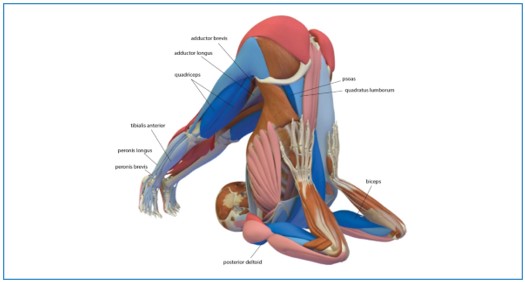Anatomical exploration of Halasana
DOI:
https://doi.org/10.21760/jaims.8.8.26Keywords:
Anatomy, Asana, Yoga, Ayurveda, HalasanaAbstract
The word “Yoga” comes from a Sanskrit root “Yuj” which means union, or yoke, to join, and to direct and concentrate one's attention.[1,2] It is a form of mind-body fitness that involves a combination of muscular activity and an internally directed mindful focus on awareness of the self, the breath, and energy.[3] Among the eight limbs of Yoga, the Yogic technique properly begins at the third limb that is the Asana.[4] Patanjali defines Asana as ‘Sthirasukhatvam” in Yoga Sutra which can be translated as stable and agreeable. The benefits of Asana range from physical to spiritual level. Asana not only tones the muscles, ligaments, joints and nerves but also maintains the smooth functioning and health of the entire body. Anatomy[5] is basically a branch of science that deals with the study of the structures of organisms and hence, anatomy Yoga is all about understanding the inner structure of the body and its different parts and learning how Yoga poses and other practices bring changes in the body. It also revolves around the layers of the mind and energies flowing within a body. In short, Yogic anatomy teaches you in detail everything related to body organs, muscles, tissues, etc. It is important for everyone to have an in-depth knowledge of body structure so that it becomes easy for them to learn body movements, maintain alignments, and identify other functions. Halasana word comes from the word Hala means plow and Asana means posture in Sanskrit. It helps to keep the spine healthy.
Downloads
References
Lasater J. The heart of Pantajali. Yoga J. 1997; 137:134–44. [Google Scholar]
Raub JA. Psychophysiologic effects of hatha yoga on musculoskeletal and cardiopulmonary function: A literature review. J Altern Complement Med. 2002; 8:797–812. [PubMed] [Google Scholar]
Collins C. Yoga: Intuition, preventive medicine, and treatment. J Obstet Gynecol Neonatal Nurs. 1998;27:563–8. [PubMed] [Google Scholar]
Rao M, A Textbook Of Swasthavritta, Chaukhamba Orientalia, Varanasi,2011, Paper 2, Chapter no. 1, page no 386
https://www.britannica.com/science/anatomy
https://en.wikipedia.org/wiki/Halasana#Etymology_and_origins
Swami Prabhavananda, "Patanjali Yoga sutras", published by the Sri Ramakrishna Math, Verse 46, chapter II
Sivananda Yoga Vedanta Center NYC [Internet]. Plough. [cited 2022 Aug 21]. Available from: https://sivanandanyc.org/plough/
Basavaradd I., editor. 21 June INTERNATIONAL DAY OF YOGA Common Yoga Protocol, Ministry of Ayurveda, Yoga & Naturopathy, Unani, Siddha and Homoeopathy (AYUSH). 4 Revised. Ministry of AYUSH | Government of India; 2019. 1–54 p. Available from: http://mea.gov.in/images/attach/Booklet_English_2017.pdf
Yoga Postures | International Day of Yoga | MEA [Internet]. Ardh Halasanaa & Halasana. [cited 2022 Aug 21]. Available from: https://mea.gov.in/yoga-postures-16.htm
https://www.artofliving.org/in-en/yoga/yoga-poses/plough-pose
Leslie Kaminoff, Yoga Anatomy, illustrated by Sharon Ellis, Human kinetics, page no. 152
Leslie Kaminoff, Yoga Anatomy, illustrated by Sharon Ellis, Human kinetics, page no. 153
https://www.artofliving.org/in-en/yoga/yoga-poses/plough-pose















